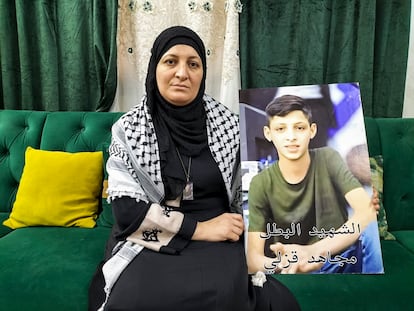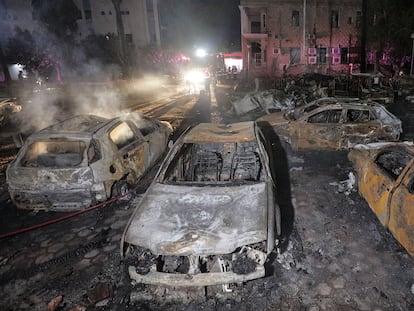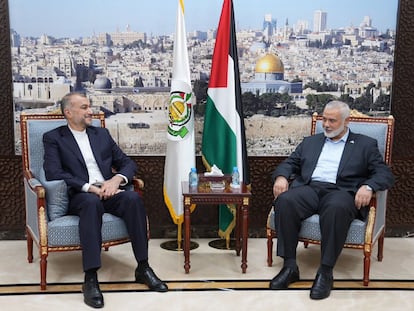‘In the neighborhood there is no family that has not lost a child’: Gaza war spreads to West Bank
The Palestinian territory has recorded 82 fatalities as a result of clashes with Israeli soldiers and ultranationalist settlers since the Hamas attack on October 7. It is a pace unseen since the end of the Second Intifada in 2005


Every time Israeli troops entered his refugee camp, Alaa would take his assault rifle and coordinate with other shabab — young people, as everyone in the West Bank euphemistically calls militiamen — from Nur Shams to lay a typical urban guerrilla ambush on the soldiers, who soon left after overcoming a mixture of gunshots, Molotov cocktails and explosives made from butane gas canisters. “Normally, they would come in to arrest someone, there would be some confrontations and they would leave. At most, they used a drone, but for surveillance,” explains Alaa, with an M-16 slung over his shoulder decorated with a sticker showing colleagues who are no longer with him. Last week, while the burials of the 1,400 Israelis killed in a massive surprise attack by Hamas were taking place, soldiers “brutally entered” this camp that houses 12,000 people near the city of Tulkarem, in the West Bank.
The troops left the area in darkness and cut off communications. The youths began to coordinate with walkie-talkies, while the bulldozers made their way through the narrow alleys of the camp, amidst drone shots and airstrikes by Apache helicopters, as if the clock had gone back two decades. “The number of houses they entered, those they demolished, their aggressiveness, none of it was normal. They put shooters on almost every corner,” he says. The result: 13 Palestinians (five of them children) and an Israeli border officer killed in 27 hours of operation.
Alaa does not remember anything like it because he had never seen anything like it: it is the bloodiest incursion into the West Bank since the Second Intifada (2000-2005), when he was just a baby who would grow up with no hope for the future. He joined the Al Quds Brigades — the armed wing of the Islamic Jihad that here monopolizes posters, graffiti and bands on the forehead — and, now, at 21, he is excited about the fragility that Israel showed on October 7, in what is already its bloodiest day in history. “Gaza has given us extra strength to defend our people and we are sending them a message: you are not alone,” he says.
Posters calling for revenge
With global attention focusing on the thousands of corpses in Israel and Gaza, the cycle of violence is also running full swing in the West Bank. At least 82 Palestinians have died in the area since October 7, an unprecedented rate in two decades. Most of the deaths occurred during confrontations with Israeli soldiers, although the number of civilians killed by ultranationalist settlers has also surged. These settlers have put up posters in Hebrew with slogans such as “Revenge” or “Raze [Gaza] + Annex = Victory.”
In Nur Shams, there is no need to look around for signs of the raid. There are bullet holes wider than usual (apparently from a type of Israeli ammunition that expands upon impact), cars burned or damaged by the passage of bulldozers, buildings in ruins, asphalt torn up on the only street where armored vehicles can fit through, sandbags, steel anti-tank barriers, signs of shrapnel on the outside of the houses, a small crater from the missile that killed seven Palestinians...

The Israeli army said in a statement that it discovered dozens of homemade explosive devices in the camp and “neutralized at least 12 terrorists,” some of them in an aerial bombardment, a common resource in Gaza but practically unprecedented in the West Bank in the last two decades. A video recorded with a cellphone shows at least six bodies on the ground, none with a firearm nearby. Another picture shows four youths huddled together at the time of impact.
Culture of martyrdom
One of them was Mujahed Qazli. He was 15 years old and his image now presides over a typical Arab living room in which the sofas occupy three walls and where the neighbors sit to offer their condolences to the family. His mother, Um Mujahed (the traditional matronym with which she prefers to be named) looks self-possessed, in part because pain and pride come together when a son dies in the context of the conflict with Israel, either actively (by immolating himself in a suicide attack) or as an innocent bystander. It is the so-called “culture of martyrdom.”
The mother says that Mujahed did not usually pray, but in the last few days he had begun to ask God that, if his time to die came, to let him die like a martyr, “just like the children of Gaza.” “Of course I see how the Israelis are acting and I am afraid of losing more children, but in the neighborhood there is no family that has not lost one. And it is easier for us, who have several children, than for other families. We have five boys and four girls. Well, now four and four,” she says.
She is wearing a pendant with a photograph of Mujahed around her neck and holding a Muslim rosary in her hand. To pose for the photo, she puts on the kufiya, the traditional headscarf that has become a symbol of Palestinian identity. She explains that, when the bombings on Gaza began — which have increased in intensity to claim over 5,000 lives — “the young people in the countryside began to go and throw stones at the soldiers.” “Then others couldn’t stand it and went to shoot at the military checkpoints, out of rage at what they were seeing on television and on their cellphones.” A teenager enters with his face covered and wearing a headband from the Islamic Jihad militia. “This is what the young people of the countryside are like,” says Um Mujahed about the maze of streets inhabited by refugees from the Nakba, the expulsion of some 700,000 of the one million Palestinians who once lived in modern-day Israel between 1947 and 1949.

Another teenager, Anas Turabi, 17, claims that the Israeli military used him as a human shield. But he downplays it because what really bothered him is that they hit him “like a sack of wheat.” “Every time we entered a house, the soldier opened the refrigerator and if he didn’t see food he would hit me,” he says, showing bruises on his side.
Turabi says that they cuffed him with his hands behind his back and a uniformed man took him out onto the street and made him walk right in front of him, with the rifle resting on Turabi’s shoulder. It was 10 hours in which from time to time the soldier attached an explosive to a door. They walked away and, when it exploded, he ordered Turabi to enter the building first in case there were militiamen inside waiting to shoot.
The Israeli army says it interrogated “dozens of suspects” and arrested 20 during the raid, out of nearly 600 in the West Bank since the Hamas attack. Residents’ accounts of the raid follow the pattern of previous raids on other West Bank towns: a dozen soldiers enter, sometimes by force, separate the men from the women and children, and interrogate the former. Farhan, 17 years old, was at his uncles’ house when the soldiers came in: “First they asked for all IDs and cell phones. And they asked me for the password. I refused, but they threatened me and I got scared. I ended up giving it to them. They immediately found a photo with martyrs from Gaza. He showed it to me and asked: What? Are you also a Hamas terrorist?”
Despite the raid, there are no sad faces. Alaa admits that the images of the deaths in Gaza sadden him, but he is confident in the role of “the resistance when [Israeli soldiers] enter on the ground.” “I am not from Hamas, but around here we all fight together. And what they did gives me the strength to keep fighting, seeing how false and weak that army is. It is not an army, it is a piece of candy.”
Sign up for our weekly newsletter to get more English-language news coverage from EL PAÍS USA Edition
Tu suscripción se está usando en otro dispositivo
¿Quieres añadir otro usuario a tu suscripción?
Si continúas leyendo en este dispositivo, no se podrá leer en el otro.
FlechaTu suscripción se está usando en otro dispositivo y solo puedes acceder a EL PAÍS desde un dispositivo a la vez.
Si quieres compartir tu cuenta, cambia tu suscripción a la modalidad Premium, así podrás añadir otro usuario. Cada uno accederá con su propia cuenta de email, lo que os permitirá personalizar vuestra experiencia en EL PAÍS.
¿Tienes una suscripción de empresa? Accede aquí para contratar más cuentas.
En el caso de no saber quién está usando tu cuenta, te recomendamos cambiar tu contraseña aquí.
Si decides continuar compartiendo tu cuenta, este mensaje se mostrará en tu dispositivo y en el de la otra persona que está usando tu cuenta de forma indefinida, afectando a tu experiencia de lectura. Puedes consultar aquí los términos y condiciones de la suscripción digital.
More information
Archived In
Últimas noticias
Welcome to the post-religion era: The idea of Christianity as the absolute truth has become obsolete
‘I thought you would like it’: The risky sexual practice popularized by TV shows and TikTok
The digitalization of tourism: ‘They promise experiences and gave us the worst possible one’
Mexican peso defies uncertainty with forecasts of a new period of stability in 2026
Most viewed
- Sinaloa Cartel war is taking its toll on Los Chapitos
- Reinhard Genzel, Nobel laureate in physics: ‘One-minute videos will never give you the truth’
- Oona Chaplin: ‘I told James Cameron that I was living in a treehouse and starting a permaculture project with a friend’
- Why the price of coffee has skyrocketed: from Brazilian plantations to specialty coffee houses
- Silver prices are going crazy: This is what’s fueling the rally










































